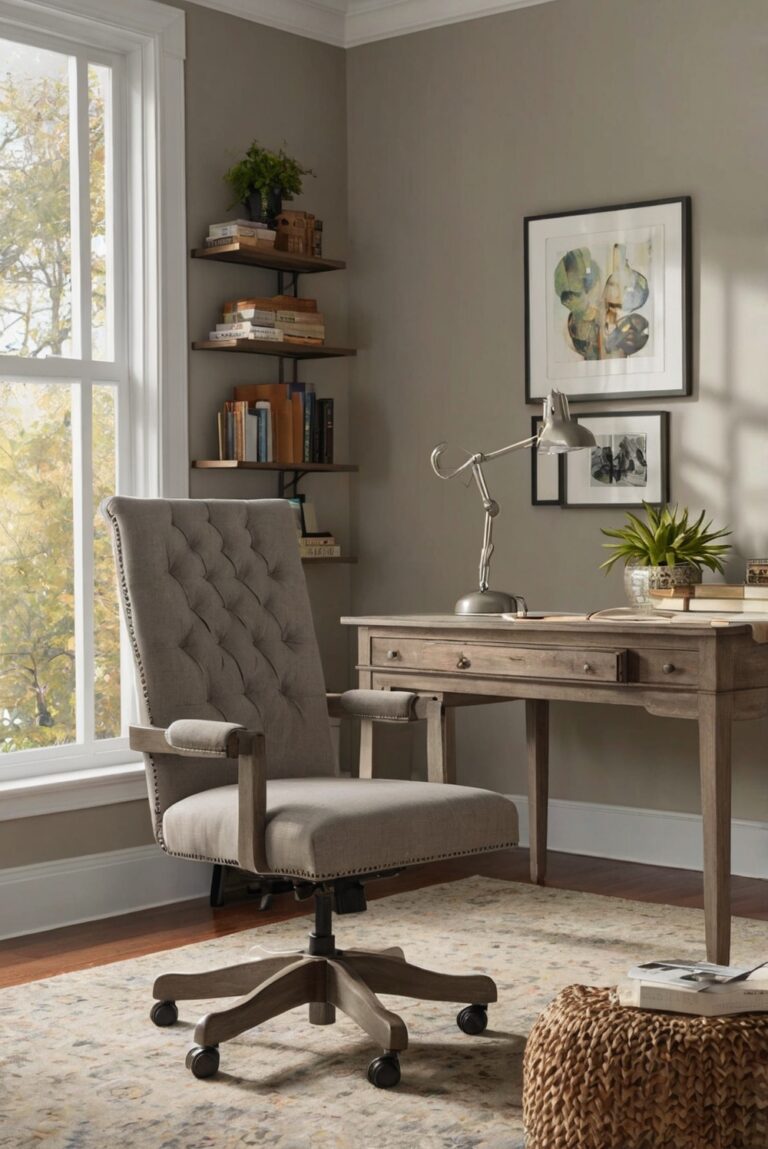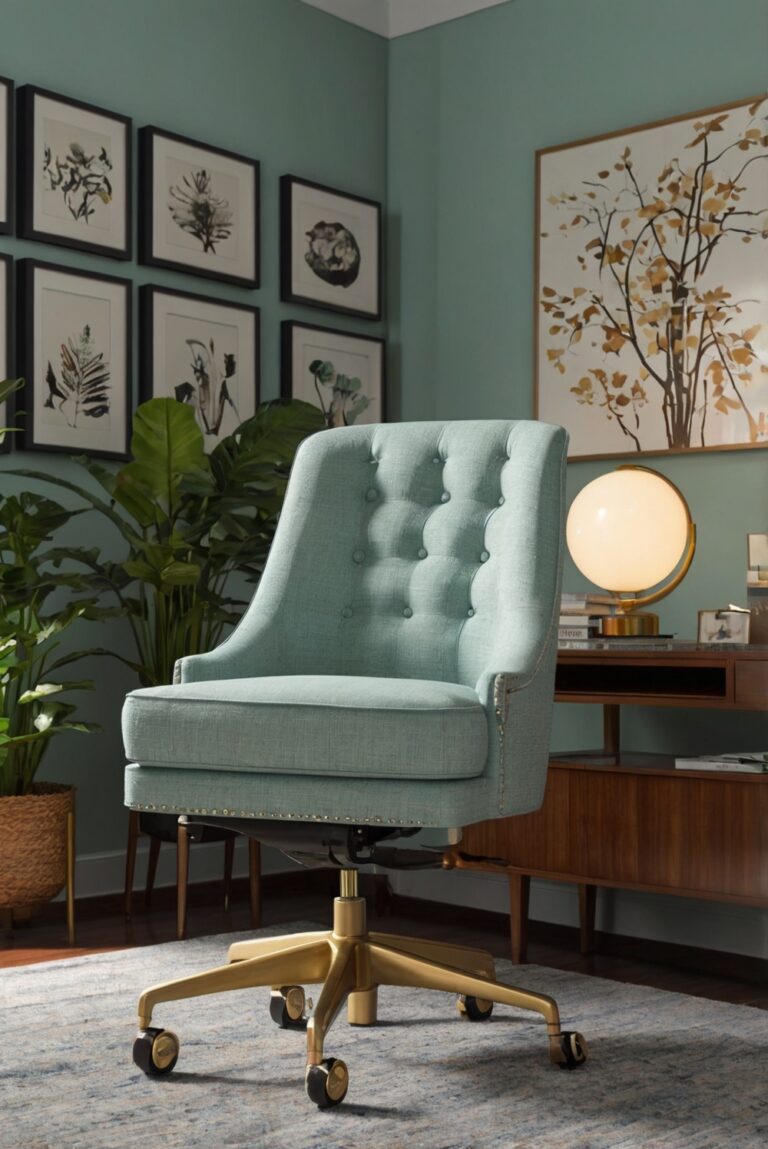Are you struggling to find the perfect chair for your home office? Discover how to select a stylish chair that supports good posture in this daily routine for interior designers.
How can you choose a chair that promotes good posture in a home office?
– Ensure the chair has proper lumbar support to maintain the natural curve of your spine.
– Look for adjustable height and armrests to align with your desk and keyboard.
– Opt for a seat with sufficient padding to prevent discomfort during long hours.
– Consider a chair with a swivel base for easy movement without straining.
– Remember to take breaks and stretch periodically to avoid stiffness and promote circulation.
– Incorporate ergonomic principles into your home office setup for overall well-being.
– Seek advice from interior designers for personalized space planning and decor solutions.
When choosing a chair for your home office, it is crucial to prioritize good posture
Proper posture is essential for maintaining comfort and preventing musculoskeletal issues. Here are some key factors to consider when selecting a chair that promotes good posture:
Ergonomic Design:
Look for a chair with an ergonomic design that supports the natural curve of your spine. The chair should have adjustable features like seat height, armrests, and lumbar support to accommodate your body’s unique needs. A chair with proper ergonomic support can help reduce strain on your back and neck.
Seat Height:
The ideal chair height allows your feet to rest flat on the floor with your knees at a 90-degree angle. Adjustable seat height is essential to ensure proper alignment and comfort. Sit in the chair and adjust the height until your feet are flat on the floor and your thighs are parallel to the ground.
Seat Depth and Width:
Choose a chair with a seat that is deep enough to support your entire thigh without putting pressure on the back of your knees. The seat width should be wide enough to accommodate your hips comfortably. Avoid chairs that are too narrow or deep, as they can cause discomfort and poor posture.
Back Support:
Proper back support is crucial for maintaining good posture. Look for a chair with adjustable lumbar support to help maintain the natural curve of your spine. The backrest should be tall enough to support your entire back and provide adequate support while sitting upright.
Armrests:
Armrests can help reduce strain on your shoulders and neck by providing support for your arms while typing or using the mouse. Adjustable armrests allow you to position your arms comfortably and avoid hunching over the desk. Make sure the armrests are at the right height to keep your shoulders relaxed.
In conclusion, choosing a chair that promotes good posture in your home office is essential for your overall health and well-being. By considering factors such as ergonomic design, seat height, seat depth and width, back support, and armrests, you can create a comfortable and supportive workspace that encourages proper posture. Remember to adjust the chair to fit your body properly and take breaks to stretch and move throughout the day to maintain good posture and prevent discomfort.
1. What are the key features to look for when choosing a chair that promotes good posture in a home office?
When selecting a chair for your home office that promotes good posture, it is essential to consider key features such as adjustable seat height, lumbar support, seat depth, armrests, and the material of the chair. Adjustable seat height allows you to customize the chair to your height, ensuring your feet are flat on the floor and your knees are at a 90-degree angle. Lumbar support helps maintain the natural curve of your spine, reducing strain on your lower back. A seat with proper depth prevents pressure on the back of your knees, while armrests support your arms to reduce shoulder tension. Opt for a breathable, comfortable material that promotes airflow to prevent sweating and discomfort during long work hours.
2. How can the ergonomics of a chair contribute to better posture in a home office setting?
The ergonomics of a chair play a crucial role in promoting good posture in a home office. Ergonomic chairs are designed to support the natural curvature of the spine, providing adequate lumbar support to prevent slouching and lower back pain. The adjustability of ergonomic chairs allows you to customize the seat height, armrests, and backrest to fit your body shape and size, ensuring proper alignment while sitting. Additionally, ergonomic chairs are often made with high-quality materials that offer comfort and stability, reducing the risk of musculoskeletal disorders associated with poor posture. Investing in an ergonomic chair can significantly improve your sitting posture and overall comfort during long work hours.
3. What role does proper chair height play in maintaining good posture in a home office?
Chair height is a crucial factor in maintaining good posture in a home office setting. A chair that is too high or too low can lead to improper alignment of the spine, causing strain on the neck, shoulders, and lower back. To ensure proper posture, your chair should be adjusted to a height where your feet can rest flat on the floor, and your knees are at a 90-degree angle. This position helps distribute your weight evenly, reducing pressure on your lower back and promoting a neutral spine position. Adjusting the chair height to fit your body dimensions is essential for preventing discomfort and promoting better posture while working in a home office.
4. How can a chair with adjustable lumbar support benefit your posture in a home office?
Chairs with adjustable lumbar support are beneficial for maintaining good posture in a home office environment. Lumbar support helps support the natural curve of the spine, reducing the risk of slouching and lower back pain. By adjusting the lumbar support of your chair, you can customize the level of support to match your body shape and maintain proper alignment while sitting. Adequate lumbar support promotes a neutral spine position, alleviating pressure on the lower back muscles and reducing the risk of developing musculoskeletal issues. Investing in a chair with adjustable lumbar support can significantly improve your sitting posture and overall comfort during long hours of work in a home office.
5. How can armrests on a chair contribute to better posture and comfort in a home office?
Armrests play a vital role in promoting better posture and comfort in a home office setting. Properly positioned armrests support your arms and shoulders, reducing strain on your upper body muscles and preventing slouching. When sitting at a desk, armrests help you maintain a relaxed posture by allowing your arms to rest comfortably at your sides. Adjustable armrests enable you to position them at the right height to support your arms while typing or using a mouse, reducing tension in your shoulders and neck. Choosing a chair with well-designed armrests can enhance your sitting experience, promote good posture, and prevent discomfort during long work hours in a home office.







